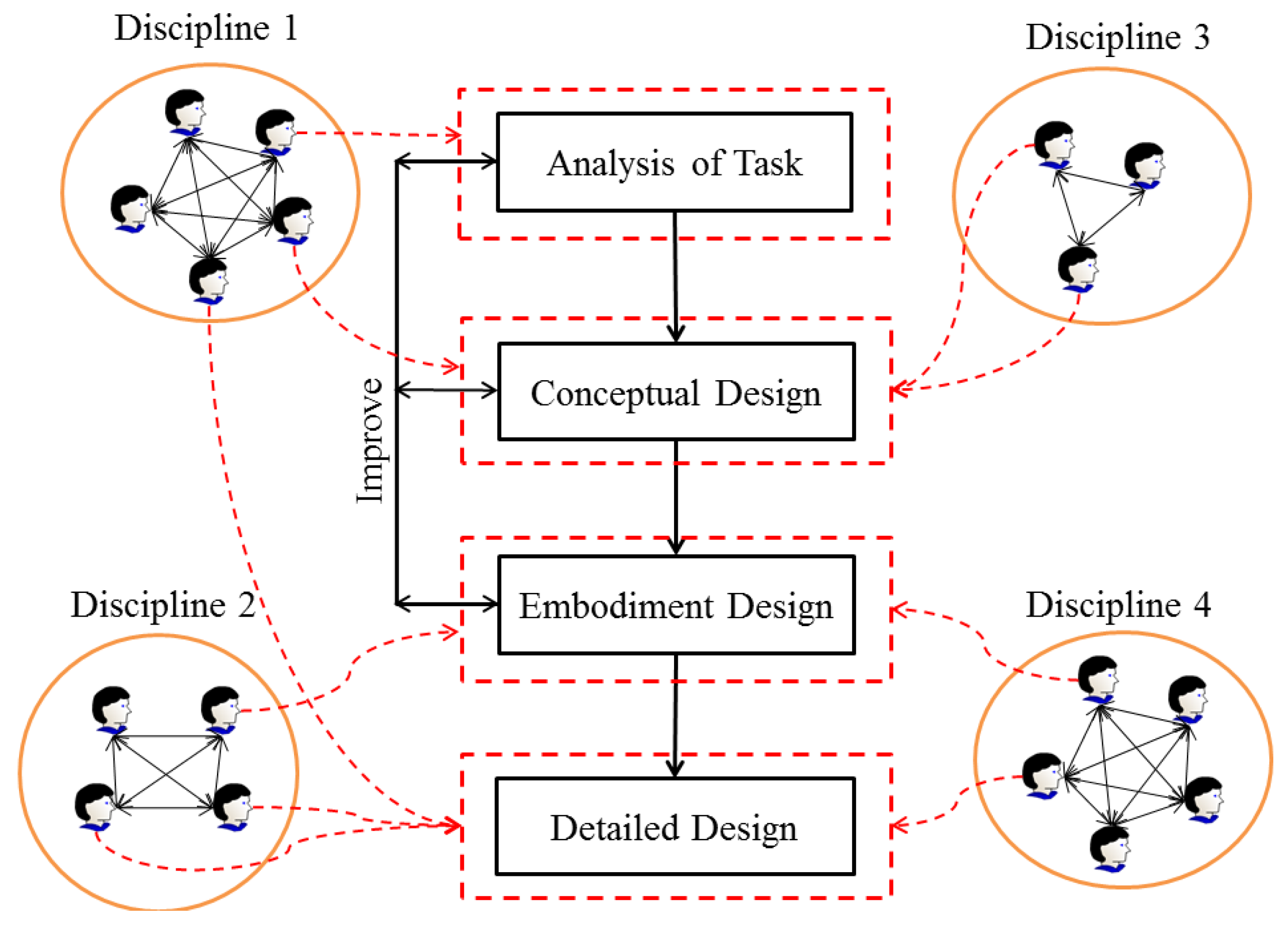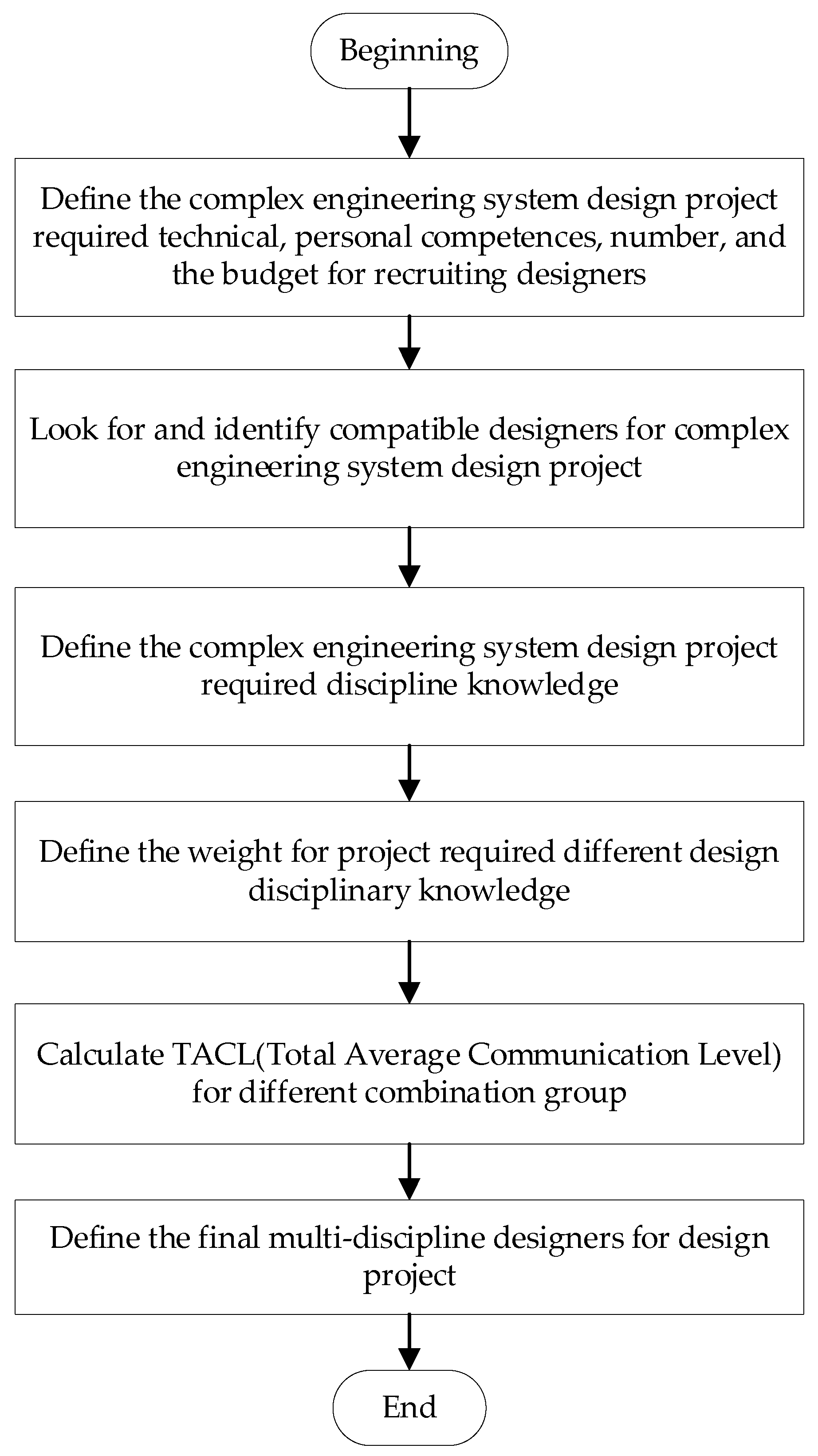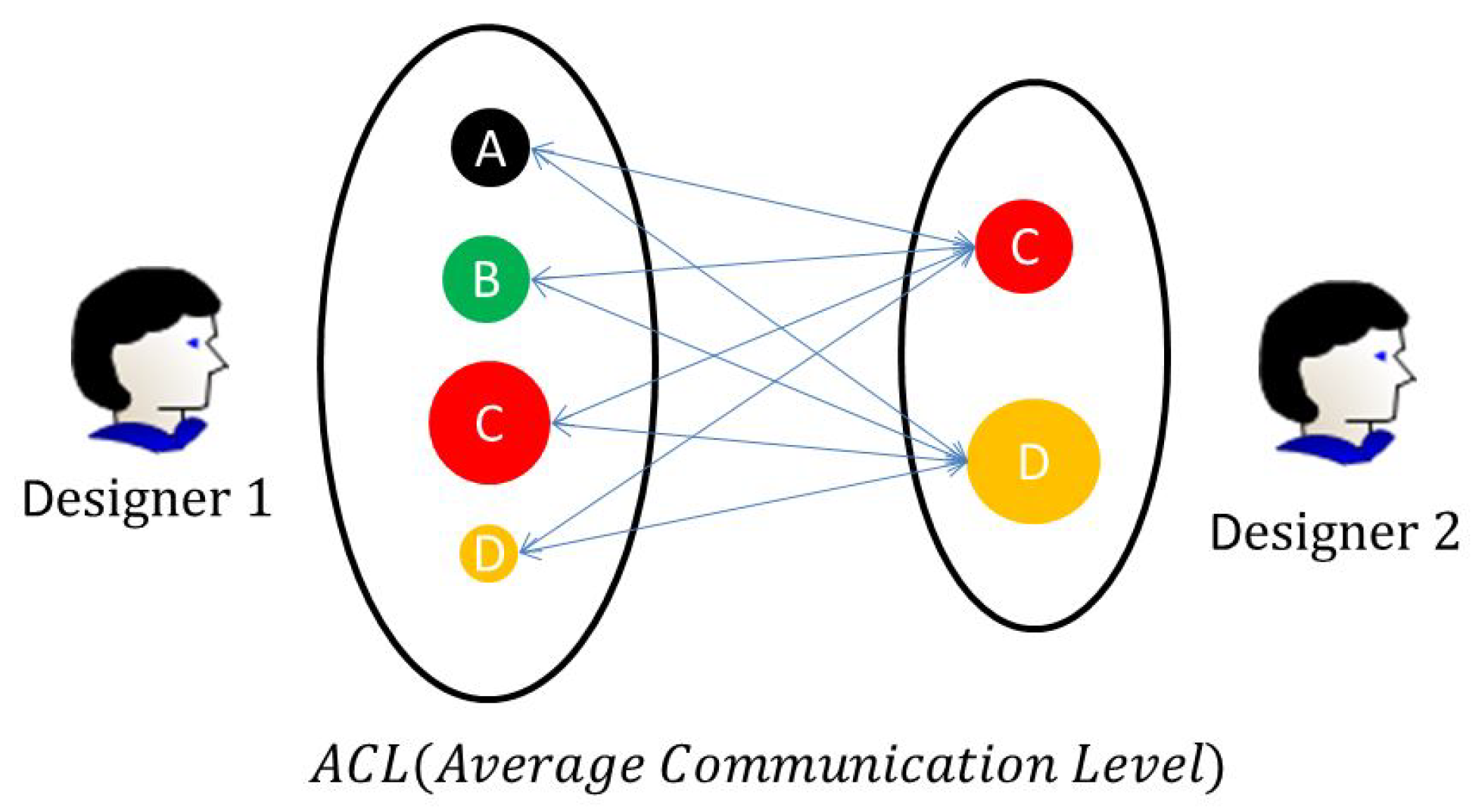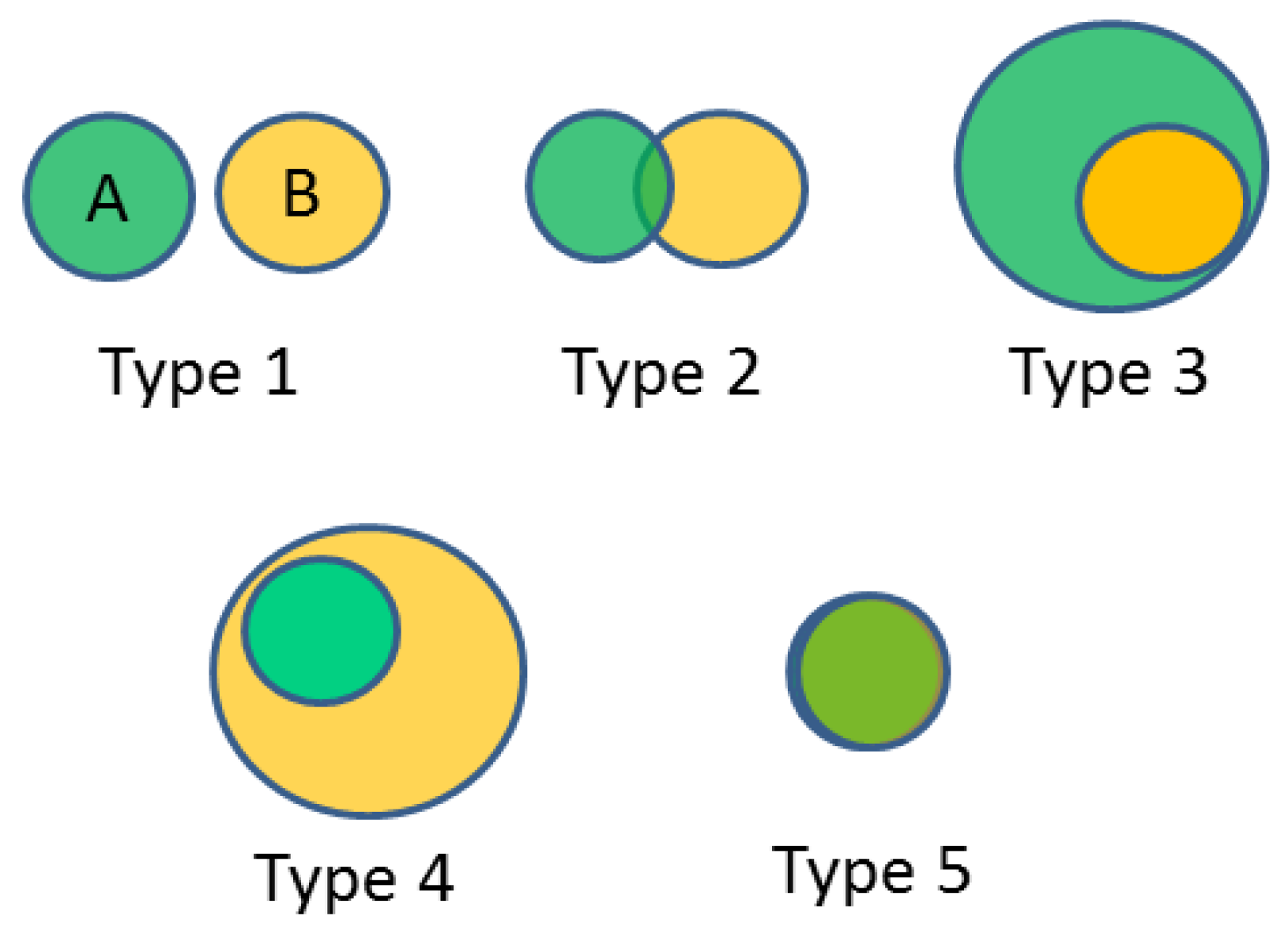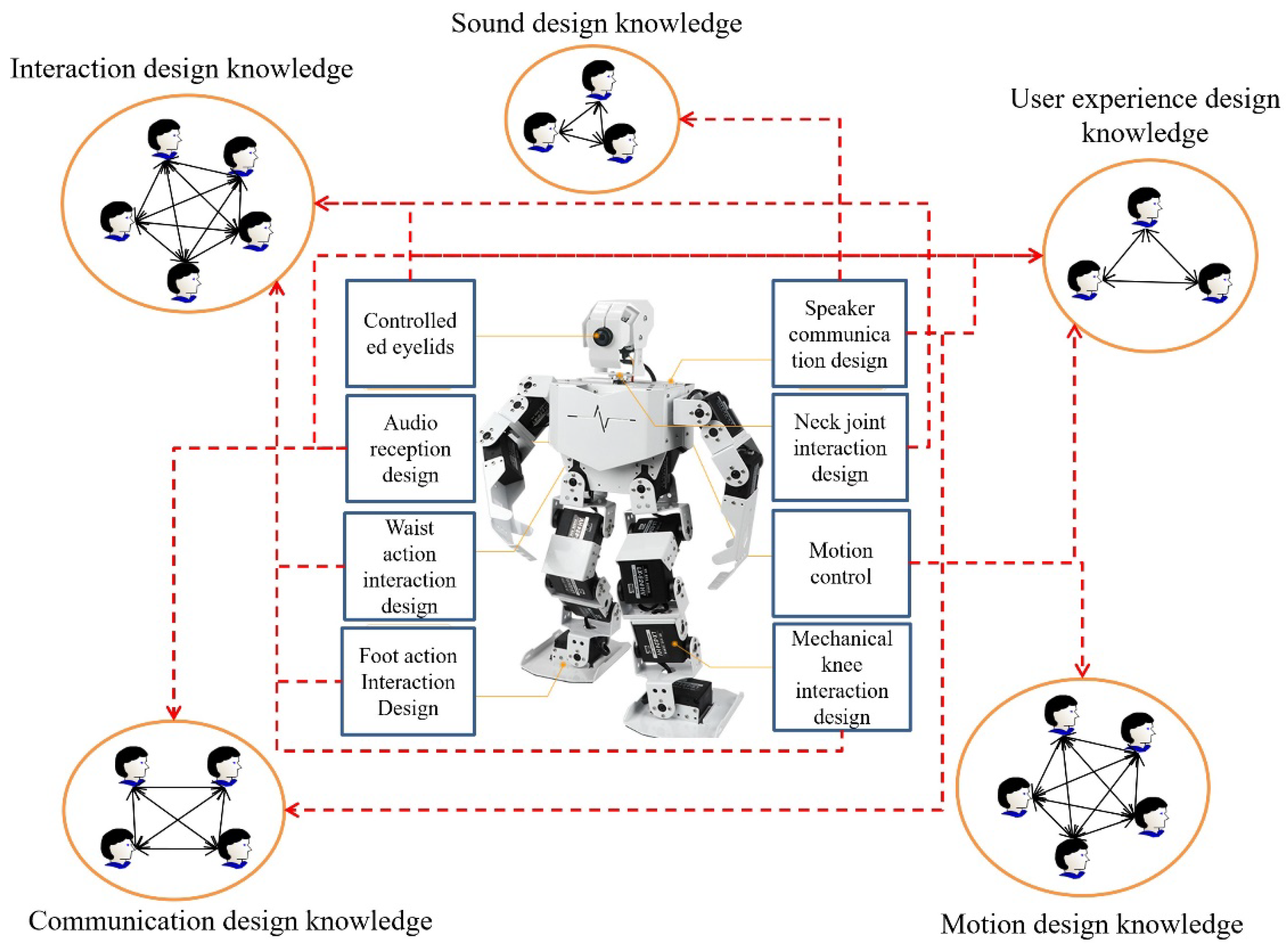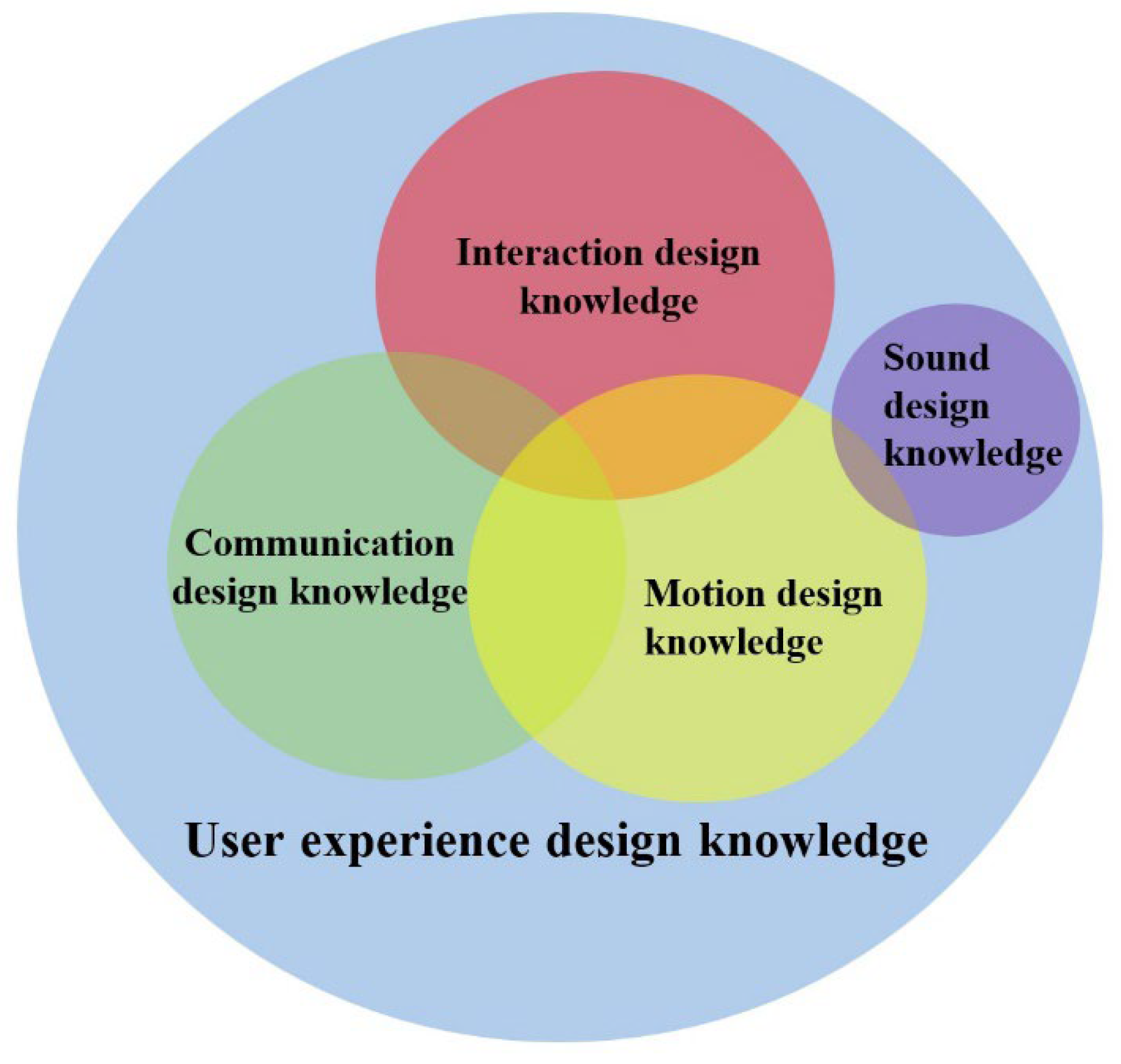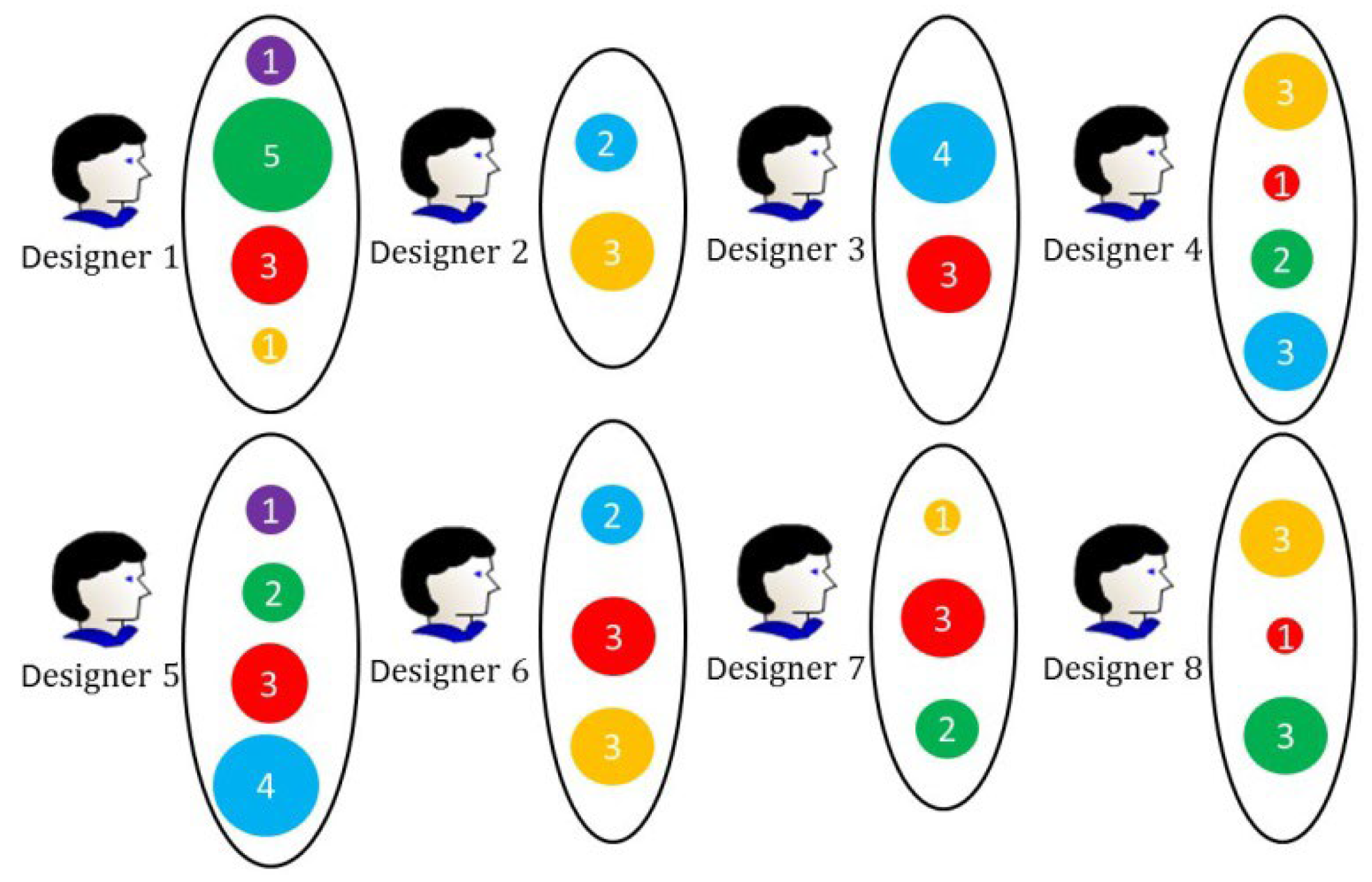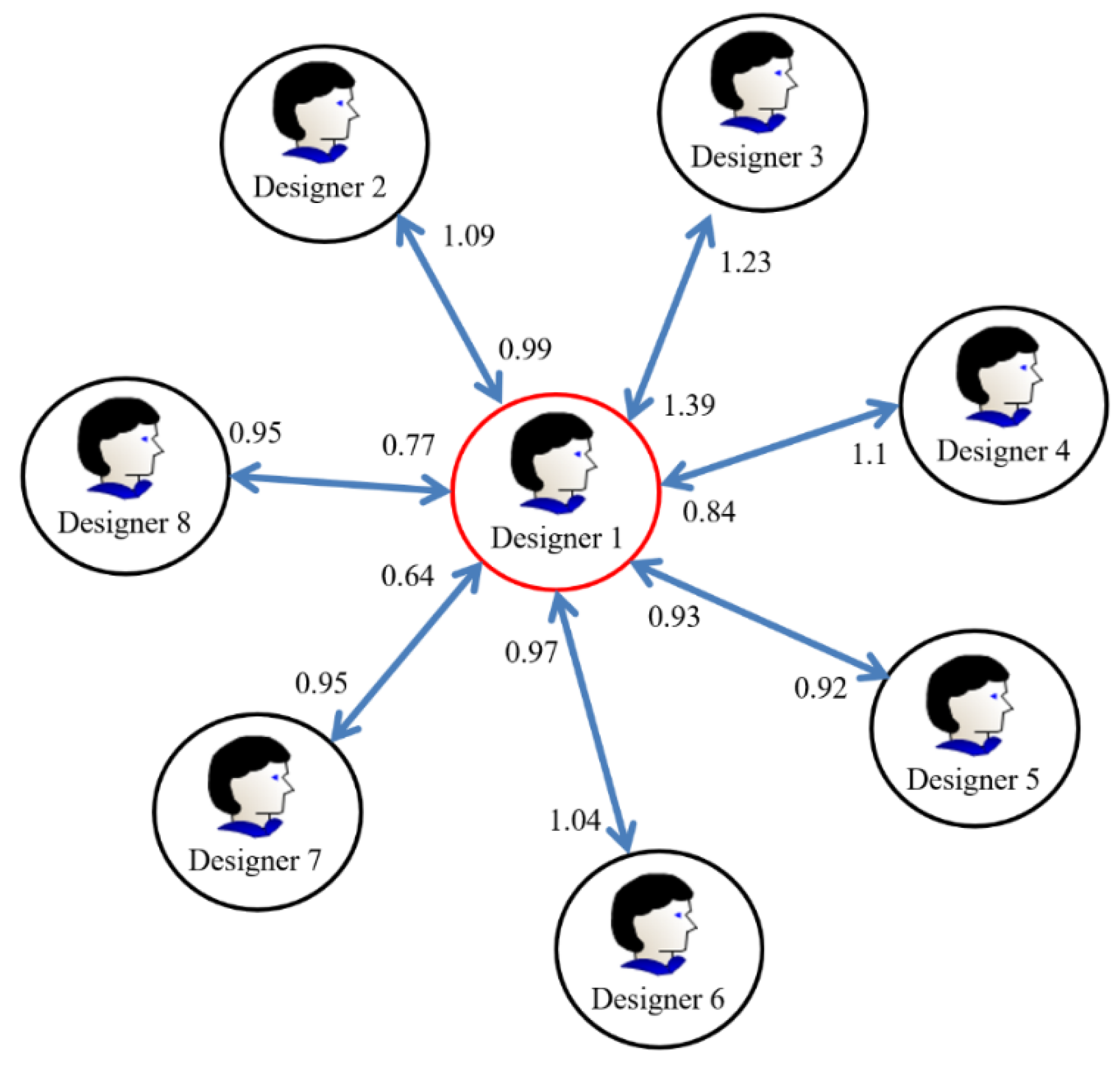1. Introduction
Design is concerned with identifying system elements and defining the interfaces and other relationships among the system elements and interfaces to entities in the system environment, including flows of information, material, and energy, both internal and external [
1]. Designers need to understand user expectations, needs, and motivations and create useful and imaginative products. Subsequently, depending on the quality of the new product, different levels of reciprocation may result. Therefore, effective product design is crucial to the overall development process of a company’s products [
2].
The design project is a multifaceted entity that exists in dynamic circumstances, exhibiting the characteristics of a design system [
3,
4]. A project is an independent one-time or long-term indefinite work task that people organize through efforts and use various methods to organize resources such as manpower, materials, and finance according to the relevant planning arrangements of the business model in order to achieve the objective [
5].
A complex system refers to a system that can self-emerge and self-organize, such as uncertain elements, heterogeneous elements, and large-scale elements, and it combines the characteristics of simple systems and stochastic systems. Furthermore, adaptability, irreversibility, and many other characteristics are incorporated [
6]. Traditional systems are expected to perform foreseeable tasks in a bounded environment, whereas complex systems are expected to function in complex, open environments with unforeseeable contingencies [
7]. Today’s complex system often emphasizes the importance of considering both cognitive and environmental factors [
8], and complex systems are often studied in different fields such as economy [
9], world trades [
10], human–computer interactions [
11], and human interactions or collaborations [
12].
The complications covered in this article concern the intermingling of multidisciplinary design knowledge. Multidisciplinary collaborative research has become increasingly prominent since the mid-20th century. The purpose of multidisciplinary collaboration is to solve or consider problems that transcend existing disciplinary boundaries. Therefore, a multidisciplinary collaborative research system may be considered a complex system in terms of its features and dynamics [
13]. In this complex system, the main issues to be dealt with are knowledge collaboration and communication across interdisciplinary fields.
Therefore, the complex engineering system design problem of this study primarily concerns dealing with the complexity of multidisciplinary engineering system designs. Designing complex engineered systems poses significant challenges for designers alike due to the inherent complexity of the systems and contexts involved [
14]. The complex engineering system design problem involves and deals with complex engineering system design issues. Therefore, it is necessary for complex engineering design companies to bring together designers with different design knowledge and theoretical and methodological backgrounds to actively participate in and solve complex engineering system design problems, resulting in interdisciplinary design knowledge exchange issues between designers.
Therefore, in order to cope with the communication and collaboration problem between multi-disciplinary designers, design companies urgently need an optimal multi-disciplinary designer selection method for complex engineering system design projects.
Therefore, the main objective of this research is to propose a designer selection method for complex engineering system design projects with the consideration of the project’s required basic technical competence, personal competence, and multidisciplinary knowledge communication between the designers. For interdisciplinary communication and collaboration efficiency within a designer portfolio, we will use the value of a design group’s Total Average Communication Level (TACL) to define it. The proposed method can help design companies, especially those designing complex engineering systems, to select efficient and collaborative multidisciplinary design teams.
The remainder of this paper is organized as follows.
Section 2 introduces the background and related research. In
Section 3, we introduce the whole process of multi-disciplinary designer selection for a complex engineering system design project.
Section 4 describes a scenario to depict experimental details and simulation results. A detailed discussion and ideas for future work are summarized in
Section 5.
2. Literature Review
In the complexity of engineering systems, the main drivers of complexity can be found in human behavior and uncertainty. This complexity, structural or dynamic, can be organizational, technological, or nested in their relationship [
15]. The context of complex engineering systems is mainly concerned with developing multi-component engineering systems, designs, or algorithms to exploit those unpredictable collective/global behaviors/properties, and the complexity in engineering systems is generally manifested in the component, product, system, interconnections between interacting subsystems, or multidisciplinary system designs [
16]. Multidisciplinary design optimization, which has evolved remarkably since its inception 25 years ago, also offers alternatives to complement and enhance the systems engineering approach to help address the challenges inherent in the design of complex engineered systems [
17]. As systems continue to grow in multiple disciplines’ scales and complexities, it is difficult for the engineering system to manage complexity, maintain consistency, and assure traceability during system development [
18].
A large and complex engineering system design project is anything that stretches beyond the scope of most design projects and usually requires knowledge from multiple disciplines to simultaneously process and solve complex problems. Therefore, large complex engineering system design projects, such as cyber-physical, artificial intelligence, machine learning, electrical, mechanical, or hydraulic engineering, automotive, aerospace, robotics, smart grids, smart manufacturing, intelligent transportation systems, etc., [
16], involve collaboration between designers from many different design disciplines in varying locations [
17].
A designer is a person who makes designs for objects. The designer can be involved in the design process [
19] using scientific and technological knowledge to create the design product. Because of the different kinds of design needs that exist, designers can hail from different disciplines. Examples include customer experience designers, experience designers, fashion designers, game designers, graphic designers, sound designers, and so on. Meanwhile, designers can also represent one or several of these disciplines depending on whether they have mastered one or several pieces of design discipline knowledge, respectively. The latter designers are multidisciplinary designers. Multidisciplinary designers can work together to approach complex engineering system design problems, especially for design problems that require the attention of multiple disciplines simultaneously.
Although different discipline knowledge exists across these designers, some of them will be interconnected, because there may be various relationships between design disciplines’ knowledge bases, such as intersections between two different design disciplines’ knowledge or one discipline’s knowledge belonging to another discipline’s knowledge.
Traditionally, the relationships among designers in an industrial design organization take place according to a hierarchical decisional structure [
20]. In this structure, the relationship among different designers is very fixed. Meanwhile, in this structure, designer management focuses more on personal ability than teamwork collaboration [
21].
However, regarding the theory of Industry 4.0, it advocates for close collaboration between various disciplines in product development [
22,
23,
24]. Meanwhile, in the fourth industrial revolution [
25], regarding design innovation in the 21st century, designers not only require necessary expertise but also collaborative flexibility with other designers to absorb complex subject information quickly [
26]. In collaborative knowledge sharing, working smarter means using technology platforms to develop trust and knowledge collaboration to deliver business solutions and innovations [
27].
Therefore, depending on the different revolutions above, the future organizational structure in the design process [
20] will be horizontal integration via external designers (
Figure 1).
Because of the development of computer-aided design and the Internet of Things (IOT) [
28], multidisciplinary designers can quickly modify and analyze designs, and it is very easy and routine to communicate with other designers. Additionally, product design teams are a growing phenomenon in many organizations; for example, design team members with knowledge of different disciplines can be combined or organized together from all over the world and collaborate with each other more frequently than before. Therefore, for the success of a large project, it is rather important how effectively people collaborate, communicate, and work together in teams [
29]. Meanwhile, because of the global, internet-driven economy and the variety of customer requirements, multidisciplinary design is becoming increasingly important to approach complex engineering system design problems. Moreover, communication and collaborative relationships within the design project team become more important for future large and complex engineering system design projects.
Complex engineering design projects can be defined as a multidisciplinary study, which is a problem-solving process that uses computational tools to extract multidisciplinary knowledge from data to solve complex engineering design challenges and provide actionable insights. It also involves the joint efforts of multidisciplinary people who work on various types of tasks to achieve a common goal, such as developing a product [
30,
31,
32]. Complex engineered system design projects involve multiple disciplines, including disciplines that are still extremely difficult to quantify and integrate into mathematical models and optimization problems [
33]. Complex engineering system design projects permit designers and engineers to incorporate all necessary disciplines simultaneously to explore the design and analysis space and select the optimal solution [
34]. In the modern age, the engineering field is rapidly evolving into a complex system with the need for multiple branches of engineering knowledge to solve modern problems. Meanwhile, multi-disciplinary experts in different engineering fields should collaborate to produce quality designs and solutions for the future [
35].
The PMBOK (Project Management Body of Knowledge) 7th edition [
4] is a standard guide to the project management body of knowledge that is widely referenced and acknowledged by most academics and companies in project and product management. It provides a basis for understanding project management and how it enables the intended outcomes [
4]. The PMBOK is a knowledge base on project management, which describes the means of project management processes in terms of integration between processes and interactions between them, and the purpose that they serve [
36]. It also describes the system within which projects operate, including governance, possible functions, and the project environment [
4]. Therefore, the PMBOK 7th edition can lead to successful projects and overcome most project management problems. In the team performance domain of the PMBOK 7th, high-performing project teams need to focus more on shared understanding and collaboration. Project teams should collaborate and communicate with each other rather than work in isolation, and they will tend to come up with more diverse ideas and ultimately achieve better results.
However, although the PMBOK is able to deal with many issues for project management, it only provides orientations and recommendations for different aspects of project management without specific implementation or quantitative methods. Therefore, this study is required to propose a specific method for multidisciplinary designer selection. Therefore, we can refer to the recommendations of the standard, but determine the specific selection methods we need to propose separately (the main contribution of this study).
For a complex engineering system design project, it is required that designers in different disciplines work collaboratively to improve product quality and shorten the development cycle [
37].
Engineering systems design is a dynamic socio-technical process where social factors such as interdisciplinary interactions and technical factors such as design interdependence and the design state co-evolve [
38]. Meanwhile, the collaboration between engineering designers with diverse technical or knowledge backgrounds, such as those found in cross-functional teams, in considered key for successful product development [
39]. Not surprisingly, more accurate constituent forecasts lead to a more accurate combined forecast.
Interdisciplinary interactions occur throughout a large complex engineering system design/development organization and become the initial conditions of the system’s engineering process that ultimately leads to the development of a viable system [
40]. In this study, interdisciplinary interaction in design refers to the situation in which multidisciplinary designers communicate and interact with each other in such a way that an analysis of their multidisciplinary design knowledge in the process of fusion and integration to produce efficiency is possible. In this context, each discipline’s knowledge or approach may have an intersectional or affiliative relationship with other disciplines. In interdisciplinary interaction relationships, the practices and conventions of each discipline work together interactively. The sense of designers’ personal discomfort with interdisciplinary interactions appears laced through many of the responses related to confusion, conflict, communication challenges, negative emotions, and additional time and effort. Therefore, in the interdisciplinary designer selection method, this study will mainly consider the efficiency of interaction between interdisciplinary designers, which includes personality competencies, as well as interdisciplinary knowledge relationships, etc.
The communication level is the potential for communication, primarily depending on the participants’ personalities. If the personality traits are not very good, they may not want to communicate with other people or have communication conflicts. Therefore, communication is a bidirectional relationship that depends on at least two participants’ personalities and abilities. However, for communication between multidisciplinary designers, the gaps in interdisciplinary knowledge can also lead to communication conflicts and misunderstandings. Therefore, when selecting optimal designers for complex engineering design projects, we should not only consider the project’s required basic technical competence and personal competences but also the efficiency of communication between designers with interdisciplinary knowledge. Thus, the main focus of this paper is on the gaps and relationships among designers with interdisciplinary knowledge. This study will also consider and evaluate the communication and collaboration personality and ability of candidate designers.
There is little related research on designer selection and even less analysis of multidisciplinary knowledge exchange in the designer selection process.
Dewulf and Reymen [
41] proposed a new approach to designer selection. The main purpose of this approach is to select designers who can take on new roles in construction projects. Therefore, the designer’s selection method focuses more on the different roles that designers play in the process of communicating with different stakeholders. Fritz et al. [
42] proposed an approach to assembling an engineering design team. This method is mainly based on the personal cognitive profile assessment of technical ability (technical aptitude, experience, etc.), drive (openness, adaptability, positive mindset, etc.), and cognitive diversity (creativity, originality, cooperation, etc.) attributes to select an effective designer team. Gul et al. [
43] proposed an integrated multi-criteria-decision-making tool for mechanical designer selection. The proposed tool binds two multi-decision criteria decision-making techniques (AHP and COPRAS) to select the most appropriate mechanical design team for construction projects. The attributes considered in this approach are technical capability, experience, and communication skills. OFLUOGL and Atilgan [
44] proposed a designer selection method based on the GRA intuitionistic fuzzy multi-criteria decision-making process, and the designer selection evaluation criteria are expertise in computer programs, organization and management skills, technical knowledge and creativity skills, etc.
Although the proposed methods above can solve the problem of designer selection, few of them consider the issue of designer selection for complex engineering system design projects. Meanwhile, for the evaluation attributes of the above-mentioned designer selection methods, most of them consider designer skills, experience, and creativity but do not consider communication and collaboration between designers. In complex engineering systems design projects, effective communication and collaboration are required among designers with multidisciplinary design knowledge. Some of the above methods also take into account the communication and cooperation between designers, such as Fritz et al. [
42] and Gul et al. [
43]. However, communication and collaboration are more concerned with designers’ personalities or willingness regarding communication, rather than analyzing the communication and collaboration problems between multidisciplinary knowledge.
Cross-disciplinary communication between designers is extensively looked upon as an important challenge for design project teams since the transfer of information between disciplines is a pre-condition for co-design [
45]. Discursive diversity is generally associated with better team performance [
46]. In the case of interdisciplinary knowledge communication, knowledge is usually transferred from one communicator to another, and the exchange of knowledge will be smoother, especially for people with a common knowledge background [
47]. Therefore, effective evaluation of the multi-disciplinary knowledge communication level between designers is very important for design team performance. Meanwhile, in practice, averaging is the optimal aggregation method when all designer communication evaluation results are independent and accurate [
48].
Designers from different disciplines can communicate and collaborate with each other from different disciplines’ perspectives. The objective of effectively managing the communication and collaboration between multiple-disciplinary designers makes it necessary to understand the relationship between different design disciplines, such as to check if there is an intersection between two disciplines. Therefore, when selecting optimal multidiscipline designers for complex engineering system design projects, analyzing the knowledge and communication ability between multidisciplinary designers is very important for future design.
The scientific novelty of this study is shown below:
For the analysis of complex engineering systems, most of them will be studied from the complexity of the system itself, such as complexity control, parallel work ability, and adaptability to future uncertainties. However, it is also very important to analyze the designers involved in system design. Therefore, an innovative aspect of this study is to analyze the interdisciplinary knowledge of designers involved in complex engineering system design projects.
Although there are many ways to analyze communication and collaboration among team members, few consider designers with interdisciplinary backgrounds. Therefore, a novel aspect of this study is analyzing the problem of communication and collaboration among multidisciplinary designers.
The third scientific novelty is that this study analyzes different types of relationships between knowledge in the two design disciplines from a new perspective.
3. Multidisciplinary Designer Selection Process
The whole process of multidisciplinary designer selection for complex engineering system design projects can be seen in
Figure 2.
The whole process of multidisciplinary designer selection for a complex engineering system design project will be controlled by the project manager. Here, the project manager can manage, coordinate, and lead designers and the planned work. As shown in
Figure 2, first, it is necessary for project managers to define the complex engineering system design project’s required technical and personal competence, number of designers, and budget for recruiting designers. The basic technical and personal competence level required and the corresponding description for recruiting designers are shown in
Table 1.
In
Table 1, the technical requirements range from level 1 to level 5, matching Novice to Expert exactly. A detailed explanation of all the technical levels can be seen as follows:
1—Novice Actor: Novice designers have little or no design experience or background knowledge. They must therefore follow a clear set of design rules or guidelines and often need supervision to complete design tasks.
2—Advanced beginner: Once novice designers have learned the basic rules of a particular design skill, they progress to advanced beginners. Here they begin to apply design rules to new design situations and receive important feedback when mistakes are made. Individuals may be able to complete some design tasks without supervision.
3—Competent: During the competence phase, designers encounter situations where design rules do not apply. This can lead to individuals being paralyzed by indecision. Over time, designers realize the futility of trying to apply every design rule in every situation. They also begin to see their actions in the context of long-term design goals through conscious, deliberate planning.
4—Proficiency: Generally speaking, someone who is proficient in design can confidently choose the appropriate design course of action in any situation. This is the transition point in learning from design-based rules to design-based situations. Reaching this stage requires many hours of deliberate practice.
5—Expert: At the design expert stage, design actions are driven by intuition generated by a deep understanding of the design subject matter. To an outside observer, the designer’s performance seems effortless and, to some extent, magical.
The project manager can use these technical levels to define the technical requirements of the project and also evaluate the technical competence of all the candidate designers.
Meanwhile, the competence requirements for complex engineering design projects include education degrees, experience, and personality competence. Here, the education degree ranges from no diploma to a doctoral degree or equivalent, and the experience degree ranges from 0–2.99 to 12 and above. Meanwhile, personal competence also includes personality competence, which will affect the communication and collaboration efficiency between designers in a design project. Here, to evaluate the personality ability of candidate designers, we will use the Five-Factor Model (FFM) [
49] and Revised NEO Personality Inventory (NEO-PI-R) [
50]. The FFM is the most widely accepted solution to the problem of describing personality structures [
49] and can reflect individual differences in personality. In the FFM, five personality factors are included: Neuroticism (N), Extraversion (E), Openness (O), Agreeableness (A), and Conscientiousness (C). Meanwhile, the Revised NEO Personality Inventory (NEO-PI-R) is one of the most popular measures of the FFM. NEO-PI-R contains a 240-item questionnaire that measures the FFM’s five personality abilities. The FFM personality criteria rank for design projects can be seen in
Table 2.
In
Table 2, the rank for every personality trait ranges from 1 to 5, which matches different personality tendency levels (very low to very high). Here, all designer personality trait competencies and personality dispositions have positive correlations, while only neuroticism is negatively correlated. Because neuroticism is essentially equivalent to emotional instability and can be seen in irritable and moody behaviors, this personality trait is detrimental to communication in design projects. After that, we have to define the weight of different personality traits. The weight for FFM personality traits is decided by company experts depending on the AHP (Analytic Hierarchy Process) method [
51]. The AHP method is one of the most promising multi-criteria tools that decision-makers have to capture both physical (objective) and socioeconomic (subjective) measures and criteria to assess different alternatives with a minimum of bias, making it an effective way to define the weight [
52]. Meanwhile, company experts can define the weights according to the different needs and objectives of the complex engineering design project. Here, the constraint is that the sum of all five personality weights is equal to 1.
After that, the company can use the NEO-PI-R questionnaire to test the personality ability of different candidate designers and the company manager can use the questionnaire results and personality criteria ranking in
Table 2 to define the five personality traits’ ranks for all the candidate designers. Then, the personality competence rank in
Table 1 is obtained by the rounded value of the weighted sum of the personality traits’ ranks.
Therefore, the company supervisor can use
Table 1 to define the technical and personal competence requirement for a complex engineering project.
After that, the company supervisor can seek and identify compatible designers for complex engineering system design projects depending on the technical and personal competence requirement for the complex engineering project.
Then it is necessary to define which kind of design discipline knowledge is required for a complex engineering system design project. Meanwhile, because the project manager cannot recruit all the multidisciplinary designers (as they should meet the project’s requirements of the number of designers) for the project (because too many members will reduce communication and decision efficiency), the project manager must determine the optimal number of required multidisciplinary designers for the complex engineering system design project. After that, the project manager can obtain different combinations of candidate designer groups depending on the number of required designers. Afterward, we can calculate the TACL (Total Average Communication Level) value for all the different combinations of groups. Then, we can determine the final multidisciplinary designers for the complex engineering system design project. Here, we calculate the TACL value because we have to select the most effective communication group with a multidisciplinary knowledge background.
The communication and collaborative relationship between two multidisciplinary designers can be seen in
Figure 3.
From
Figure 3, we find that Designer 1 has mastered four knowledge disciplines (A, B, C, and D), while Designer 2 has mastered two knowledge disciplines (C and D). Meanwhile, each discipline’s knowledge is measured against the mastery level of the discipline knowledge for that designer (represented by the different sizes of the circles). When two multidisciplinary designers communicate with each other, they will use their multidisciplinary knowledge to communicate with each other. Therefore, there will be different disciplinary knowledge communication conflicts between them. Therefore, the communication efficiency between two multi-disciplinary designers depends on how much their multidisciplinary technology knowledge can be understood by the communicating designer. Therefore, we must calculate the average communication level (ACL) ((1)) to define the communication level between two multidisciplinary designers.
To calculate the ACL, we must first define the disciplinary knowledge acquisition level. The skills acquisition model of Dreyfus [
53] offers a welcome solution for such measurement. We identify five levels for the disciplinary knowledge acquisition level, from novice to expert. The exact description of every level can be seen in
Table 3.
In
Table 3, disciplinary knowledge acquisition can be divided into five levels, from novice actor to expert, followed by the different level values.
After we define the disciplinary knowledge acquisition level, we must define the relationship between two design discipline knowledge designers. The relationship types of two different design discipline knowledge designers are shown in
Figure 4.
Figure 4 shows that there are five types (Type 1, Type 2, Type 3, Type 4, and Type 5) of relationships between two design discipline knowledge designers. Type 1 means that there is no relationship between the knowledge of the designers who master design discipline knowledge A and the designers who master design discipline knowledge B. Type 2 means that there is a knowledge intersection between the designers who master design discipline knowledge A and the designers who master design discipline knowledge B (e.g., both information architecture design knowledge and communication design knowledge contain application design knowledge). Type 3 means that the knowledge of designers who master design discipline knowledge A includes all the knowledge of designers who master design discipline knowledge B. Type 4 means that all the knowledge of designers who master design discipline knowledge A belongs to the knowledge of designers who master design discipline knowledge B. Finally, Type 5 means that the knowledge of designers who master discipline knowledge A is the same as that of designers who master discipline knowledge B (i.e., discipline knowledge A and discipline knowledge B are the same knowledge). The rank for different discipline knowledge designer relationship types can be seen in
Table 4.
In
Table 4, a higher value of RAB means that the communication is more fluent from the designer who masters A to the designer who masters B and vice versa.
After that, we can release the target function (Equation (1)) of this study and the corresponding constraints (Equation (3)). The main objective of the target function (1) is to calculate the
TACL value. The detailed calculation process of
TACL can be seen in (1) to (3).
Note. ACL = Average Communication Level for one pair designer. DL = Discipline knowledge acquisition level. Rab = Rank of relationship from discipline a to discipline b. N = Number of mastered disciplines for collaboration designer. M = Number of mastered disciplines for the collaborated designer. TACL = Total Average Communication level for one design group. U = Total number of designers in one group. Q = Total number of communication pairs in one group. Cu = Recruitment cost of the uth multidisciplinary designer in one combination group. B = Budget for recruiting one designer combination group.
The target function (1) allows us to maximize the total average knowledge communication level for one designer combination group. In Equation (1), “
U” represents the total number of designers in one group. In Equation (2),
DL represents the discipline knowledge acquisition level, which is defined in
Table 3.
R represents the rank of the discipline relationship, which is defined in
Table 4. “
ω” is the weight of discipline knowledge. A higher value of “
ω” reflects higher importance of the discipline knowledge to the project. For the coefficient value “
ω”, the project manager can use the AHP (Analytic Hierarchy Process) [
54,
55,
56] method to define it. The AHP method is a simple, flexible, and practical multicriteria decision-making method for quantitative analysis of qualitative problems [
57]. Meanwhile, in the AHP framework, the pairwise comparison method is used for determining the relative importance (weight) of a parameter, such as a criterion or an alternative with regard to other parameters [
58]. In fact, the hierarchical structure of the AHP method is able to measure and synthesize a variety of factors of a complex decision-making process in a hierarchical manner, making it simple to combine the parts into a whole [
59]. For the definition of the weight value of different discipline knowledge, experts are required to make subjective judgments on the qualitative and quantitative indicators of the different disciplines of knowledge. Therefore, it is adaptable to use the AHP method to define the weights (importance) of design discipline knowledge. We can establish a multi-level hierarchical structure for design discipline knowledge weight definitions as seen in
Figure 5.
In
Figure 5, we can observe that there are two levels of the hierarchical structure. Level 0 is the main target or criteria to be considered to define the weight for design knowledge disciplines. Level 1 is the multiple standards that consist of different design disciplines’ knowledge required for the complex engineering system design project. The reason there are only two levels of hierarchical structure is that we only need to use the AHP method to define the weight of all design knowledge disciplines.
The basic scale for pairwise comparisons is shown in
Table 5.
The company manager can use
Figure 5 and
Table 5 to pairwise compare each two design discipline knowledge sets depending on the different criteria of the complex engineering design project. Then, it is possible to employ the right eigenvector of the pairwise comparison result and define the weights (ω) of discipline knowledge.
After that, to obtain the value of ACL (Equation (2)), we have to calculate all the disciplinary knowledge communication between designers and divide it by the total number of discipline knowledge communication pairs (N·M in (2)). Then, we can calculate the ACL value for every two designers in the group and divide the total number of communication pairs in the group to determine the TACL value (1). Here, we need to consider the budget for hiring a group of multidisciplinary designers (3). After that, the project manager can use the TACL value to select the most adaptable designers to communicate and solve complex engineering system design problems. A higher value of the TACL represents higher communication efficiency.
4. Analysis of an Example
Robotics is one of the most complex engineering systems, and socially interactive robots are expected to play an increasingly important role in human society [
60]. The complexity of socially interactive robot systems has dramatically increased, from the perspective of both single-social-robot design and interacting multi-social-robot systems [
61]. Design teams of social robots are often multidisciplinary due to the broad knowledge from different scientific domains needed to develop such complex technology [
62]. Different design disciplines’ knowledge can make a decisive contribution in terms of human–robot interaction by investigating new and transversal approaches to the project [
63].
Here, multidisciplinary design collaboration is always needed to capitalize on the strengths of different designers to develop shared knowledge and better deal with the complex combinations of interacting activities, behaviors, and relationships that affect design work [
64]. In fact, while solving complex engineering design problems, all design team participants cross knowledge boundaries and synthesize practices from each other’s disciplines [
65]. It was also highlighted that the act of more frequent design knowledge interactions leads to a faster shift in mindset between the knowledge from different design disciplines [
66].
At the same time, many researchers have proposed social robot co-design tools that can be applied to different parts of the design process to facilitate collaboration between experts in different disciplines, and an engineering system design company also places great importance on multidisciplinary design [
62,
63,
64,
65,
66,
67,
68,
69].
Analysis of the efficiency of multidisciplinary design knowledge interactions is therefore very important in the selection of candidate design teams for complex engineering system design projects.
Meanwhile, the design of such robots emphasizes the need for a positive user experience. User experience design in socially interactive robots refers to any interaction a user has with the robot or robot service, and user experience design considers each and every element that shapes this experience, how it makes the user feel, and how easy it is for the user to accomplish their desired tasks [
69]. User experience design is related to multi-disciplinary knowledge about interactive design knowledge, communication design, motion design, sound design, human factors and ergonomics, architecture, and so on. A positive user experience does not appear by itself but has to be designed and evaluated systematically [
60].
Therefore, in this example, we consider a user experience design project for socially interactive robots. The basic required technical and personal competences, the number of designers, and the budget for recruiting designers are shown in
Table 6.
In this example, we consider approximately 10 multidisciplinary designer candidates. The company supervisor can use
Table 6 to select designers who meet the project needs. The technical and personal competences of the 10 candidate designers are shown in
Table 7.
In
Table 7, we can find that the education degree (high school diploma (2)) for Designer 9 and experience (2.0 years) for Designer 10 cannot meet the complex engineering system design project requirements in
Table 6 (the minimum education degree requirement is a Bachelor’s Degree or equivalent (3) and the experience requirement is 3–5.99 (2) years). Meanwhile, the detailed calculation of personality competence for all candidate designers in
Table 7 is shown in
Table 8.
In
Table 8, we can find that the weights for the five personality traits are 0.04 (Conscientiousness), 0.42 (Neuroticism), 0.07 (Openness), 0.29 (Agreeableness), and 0.19 (Extraversion). In this example, six design company experts will be involved to define the weights for five personality traits. The pairwise comparison matrix and weight results for the six experts can be seen in
Table A1,
Table A2,
Table A3,
Table A4,
Table A5 and
Table A6 (
Appendix A). Furthermore, the final average weights of the six experts for the five personality traits are shown in
Table A7 (
Appendix A).
Here, personality competence is obtained by the rounded value of the weighted sum of personality traits’ ranks. In
Table 8, for example, the personality competence for Designer 1 is 4 (4 × 0.04 + 3 × 0.42 + 5 × 0.07 + 4 × 0.29 + 4 × 0.19 = 3.69 and rounding 3.69 will equal 4). Thus, in
Table 7, the personality competence of Designer 9 (1) and Designer 10 (2) also cannot meet the project requirement (3 for personality competence in
Table 6).
Therefore, the company supervisor can select Designer 1 to Designer 8 for the next screening step.
After that, we can analyze the multidisciplinary knowledge communication efficiency of these eight designers. The required discipline design knowledge for socially interactive robots can be seen in
Figure 6.
From
Figure 6, we can find that user experience design for interactive robots has eight design parts (Controlled eyelids, Audio reception design, Waist action interaction design, Foot action interaction design, Speaker communication design, Neck joint interaction design, Motion control, and Mechanical knee interaction design parts). Here, different disciplines of design knowledge can approach one or several design parts, such as the designer who has communication design knowledge can approach Audio reception design and Speaker communication design parts. From
Figure 6, we can also find that the user experience design project requires five design knowledge disciplines in total (sound design knowledge, motion design knowledge, communication design knowledge, interaction design knowledge, and user experience design knowledge).
The detailed explanation of these five design knowledge disciplines can be understood as follows:
Sound design knowledge: This is related to sound recognition, processing the logic program, speech synthesis, voice recording and playback, and robot voice control.
Motion design knowledge: This is related to using artificial methods and technologies to endow a computer or robot with human-like emotions, so that it has the ability to express, recognize, and understand joy and sorrow, and to imitate, extend, and expand human emotions.
Communication design knowledge: This is related to man–machine dialogue knowledge.
Interaction design knowledge: This is related to the design field that defines and designs the behavior of artificial systems and defines the content and structure of communication between two or more interacting individuals so that they can cooperate with each other to achieve a certain kind of purpose.
User experience design knowledge: This is a user-centered design method that aims at user needs. The design process focuses on the user at the center, and the concept of user experience enters the whole process from the earliest stage of development and runs through it.
Meanwhile, there are five multidisciplinary designers (
Table 6) required for the user experience design project, and the company’s budget for hiring all five designers is
$16,000 (
Table 6). Therefore, we have to choose five designers from the eight multidisciplinary designer candidates within the budget.
The relationship between the five disciplines of design knowledge, multidisciplinary design knowledge information, and the recruitment fees for eight candidate designers can be seen in
Figure 7 and
Figure 8 and
Table 4.
From
Figure 7, we can find that there are five design knowledge disciplines with different relationships to each other.
From
Figure 8, we can find that there is different multidisciplinary design knowledge for all eight designers with different knowledge acquisition levels (the sizes of the colored circle and the number in the colored circles represent the disciplines’ knowledge acquisition levels in
Table 3). The color of the circle matches the color in
Figure 5. Because the complex engineering system design project requires five multidisciplinary designers, for the eight candidate designers, there are 56 types of combination groups in total.
Depending on the company’s recruitment budget, the total cost for one type of multidisciplinary combination group in
Table 9 cannot exceed
$16,000.
After that, we can use
Figure 7 and
Table 4 to define the different design discipline designer relationship ranks (RAB and RBA in
Table 4) for these five knowledge disciplines (
Table 10).
Meanwhile, the project manager can use the AHP method to define the design disciplines’ importance coefficient values (“ω” in (2)). To use the AHP method, the project manager has to define the objectives for the project. Here, we consider a brand visual and auditory design project, and the objectives for the project can be understood as follows:
Producing high-quality visual designs and illustrations to convey a story narrative or idea from concept to execution.
Improve the feeling of brand loyalty.
New or redesigned brands must be visually trusted by the customer to support the brand promise.
Decrease cost.
Increase the customers’ satisfaction.
The brand sounds special and comfortable.
Depending on the design project objectives outlined above, the project manager can use the fundamental scale for pairwise comparisons shown in
Table 5 to pairwise compare the five design knowledge disciplines in
Figure 7 and determine their weight (
) (
Table 11).
The weight results in
Table 11 are determined from the principal right eigenvector of the pairwise comparison result matrix in
Table 11.
After that, we can use
Table 9 and
Table 10,
Figure 8, and (1) to calculate the ACL value for every two designers. The result of the ACL value for every two designers can be seen in
Table 12.
From
Table 12, we can find the ACL values of the relationship between every two multidisciplinary designers. Here, a higher value of the ACL represents higher communication efficiency between the two multidisciplinary designers. The example of the communication relationship between Designer 1 and other designers in
Table 12 can be seen in
Figure 9.
The weights of the ratios in
Figure 9 are obtained by the Average Communication Level (ACL) value between two designers in
Table 12. For example, the ACL value from Designer 1 to Designer 2 is 1.09. From
Figure 8, we can find that there are four types (Interaction Design Knowledge, Sound Design Knowledge, Motion Design Knowledge, and Communication Design Knowledge) of multidisciplinary knowledge for Designer 1 and two types (Motion Design Knowledge and User Experience Design Knowledge) for Designer 2. Therefore, when Designer 2 communicates with Designer 1, we have to analyze the relationship between the four types of multidisciplinary knowledge for Designer 1 and the two types of multidisciplinary knowledge for Designer 2. Meanwhile, according to
Table 11, the weights for the five types of disciplinary knowledge are 0.21, 0.15, 0.20, 0.21, and 0.23. Thus, depending on Equation (2), all the weights, and the different design discipline designer relationship ranks in
Table 10, the ACL value from Designer 1 to Designer 2 is 1.09 (
=
).
After that, we can use target function (1) and constraint (3) to determine the result of TACL for all different combination groups. The top 10 groups with the largest TACL values that can satisfy constraint (3) can be seen in
Table 13.
In
Table 13, we can find that the highest value of TACL (1.43) is seen for group D2-D3-D4-D5-D6. This means that multidisciplinary communication in this group (Designer 2, Designer 3, Designer 4, Designer 5, and Designer 6) is the most efficient compared to other combination groups.
The reason we choose type 1 in
Table 13 is that group D2-D3-D4-D5-D6 has the highest value of TACL. The higher TACL value means the total average multidisciplinary design knowledge communication level for one design group is better than other groups. Here, we consider the different relationship types between two design discipline knowledge designers, as well as the weight and level of discipline knowledge mastered by designers. Therefore, Type 1 groups communicate and collaborate most efficiently in a multidisciplinary knowledge environment. Thus, the project manager can choose Designer 2, Designer 3, Designer 4, and Designer 5 for the complex engineering system design project.
To test the effectiveness of the results, we compared the project communication efficiency of other randomly assigned groups of designers (Type 9 and Type 10 in
Table 13) with the optimal outcome group (Type 1 in
Table 13). In order to test the effectiveness of team communication, we let all these combinations carry out the user experience design project and then conducted a questionnaire survey with the team members (satisfaction values range from 0–4, matching very dissatisfied to very satisfied) to judge their feelings about the project efficiency in their combinations. The results of the questionnaire survey can be seen in
Table 14.
From
Table 14, the average communication efficiency value for the optimal outcome group (T1) is higher than the other randomly assigned groups (T2 and T10 in
Table 14) of designers. Therefore, we can find that the proposed designer selection method for complex system design projects is effective. Therefore, in the final phase, the project manager can select group type 1 in
Table 14 for the complex engineering system design project.
5. Discussion and Conclusions
The selection of multi-disciplinary designers is one of the most important issues for complex system engineering projects to be completed effectively. The effective selection of multidisciplinary designers can ensure that complex system engineering project teams are able to communicate and collaborate effectively across multiple design disciplines. Therefore, the main contribution of this research is to propose a multidisciplinary designer selection method for complex engineering system design projects with consideration of the project’s required basic technical competence, personal competences, and multidisciplinary knowledge communication between the designers. In the personal competences section, we analyzed the education level, experience, and personality competence of the candidate designers. Here, personality competence can directly affect the communication and collaboration between designers. Therefore, we used the Five-Factor Model (FFM) [
49] and the Revised NEO Personality Inventory (NEO-PI-R) [
50] to test and evaluate the personality ability of the candidate designers. In addition to that, in the multi-disciplinary interaction section, we used the concept of the Average Communication Level (ACL) (
Figure 3), the ranking for different design discipline knowledge designer relationship types (
Figure 4 and
Table 4) and the corresponding equations (Equations (1)–(3)) to determine the Total Average Communication Level (TACL) value. The TACL value helps to select efficient and collaborative multidisciplinary design teams. Therefore, the proposed method can help design firms to select the best multidisciplinary collaborative design team for complex engineering system design projects.
Meanwhile, in
Table 13, we find that the group consisting of Designer 2, Designer 3, Designer 4, Designer 5, and Designer 6 has the highest value of TACL. Furthermore, from the five design disciplines’ knowledge information in
Figure 8, we can also find that only Designer 2, Designer 3, Designer 4, Designer 5, and Designer 6 have the User Experience Design Knowledge (UEDT) competence (Color Blue). Meanwhile, the weight of the UEDT across all five disciplines knowledge in
Table 11 is the most important value (0.23). It is therefore easy to determine that designers with higher-weight competencies are more likely to have good collaborative communication outcomes than those with lower-weight competencies. Meanwhile, from the ranking of different design discipline knowledge designer relationship types in
Table 4, we can find that the proper subset or proper superset relationship will be better than thee knowledge intersection between the designers. To increase the output of the cooperation between these designers, the project manager can select designers with higher-weight competencies and proper subset or proper superset relationship designers.
In this research example, the budget for recruiting designers cannot exceed
$16,000 (
Table 6). Here we consider the company recruiting staff has a certain degree of budgetary constraints and the company cannot increase the budget indefinitely. Therefore, the paper only provides an example as a reference for the company, and for a competitive organization, it may have a budget in excess of
$16,000.
Although the methodology was developed for multidisciplinary designer selection for s complex engineering design project problem, it is also adaptable for the selection of other projects, with slight modifications such as redefining the rank for different disciplines’ knowledge (
Table 4) and redefining the weight for different disciplinary knowledge (Equation (2)). In this research, we mainly focus on communication and collaboration among multidisciplinary designers. However, the first step is better communication, and it is also necessary to determine the method of generating the desired outcomes for design projects. Here, it is necessary to analyze the relationship between the assigned design team regarding good communication efficiency and the expected outcome of the completed project. For example, in terms of project completion, a team with good interdisciplinary communication will, of course, contribute to the quality and timing of the project, but more specifically, it is necessary to quantify how much the interdisciplinary aspects of the design team (disciplinary weighting, disciplinary rank, number of disciplines mastered, etc.) contribute to the completion of the project. Therefore, further studies will need to focus on other types of projects and analyze the relationship between the assigned design team regarding good communication efficiency and the expected outcome of the completed project.
In this paper, we proposed a method to approach multidisciplinary designer selection for a complex engineering system design project. In this study, we used the AHP method [
54] and the Skill Acquisition Model [
53] to define the weight and level of the designers’ mastered discipline knowledge. Meanwhile, we used the mathematical relationship to define the different design discipline knowledge relationships. In addition, we considered the efficiency of communication between designers depending on these relationships. Finally, project managers can use this method to select multidisciplinary designers and take these designers into account for complex engineering system design projects to efficiently approach complex engineering system design problems.
